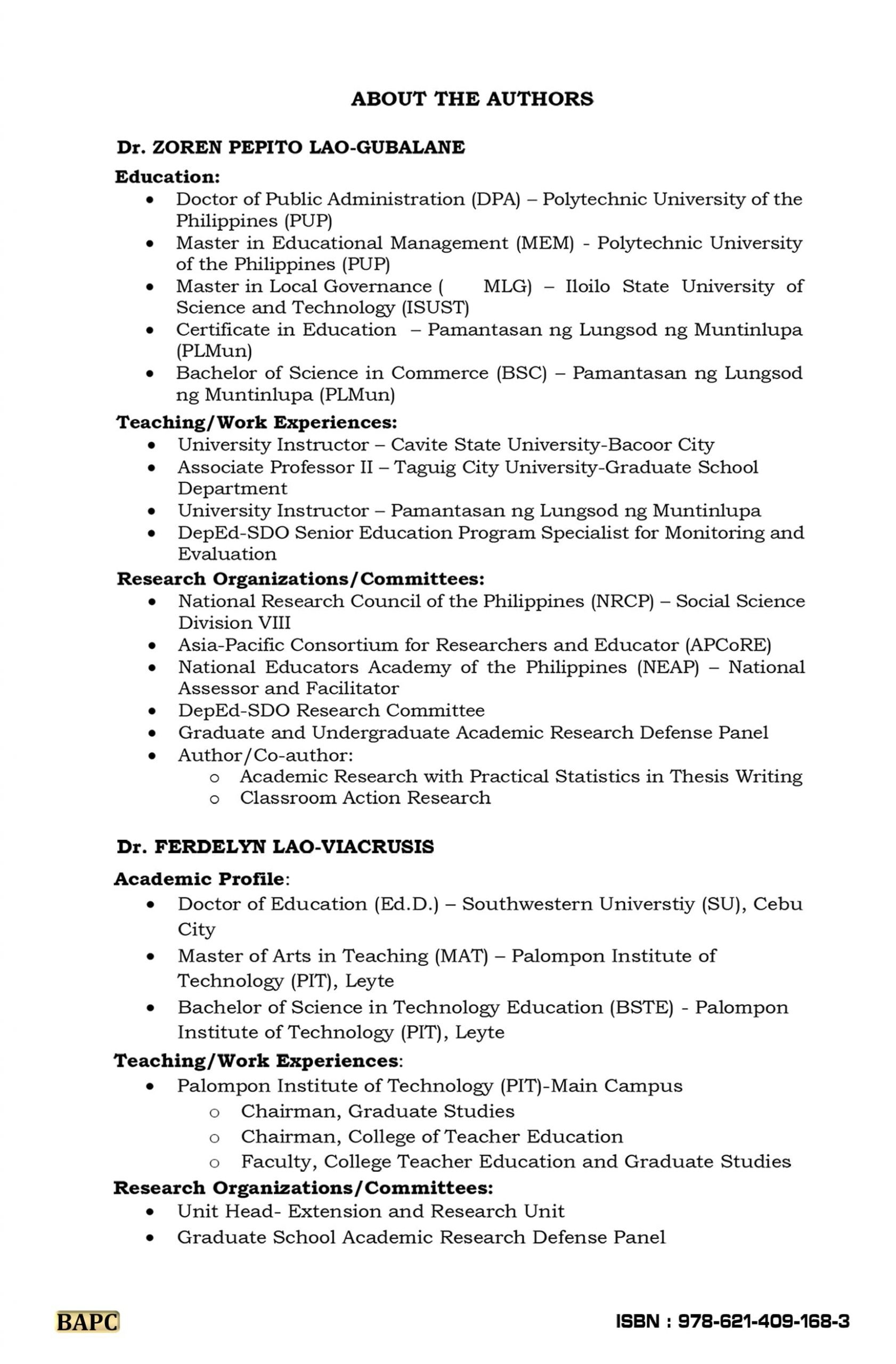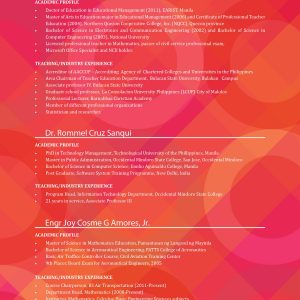ACADEMIC RESEARCH with Practical Statistics in Thesis Writing
₱300.00
ISBN: 978-621-409-168-3
Author: Zoren Pepito L. Gubalane, DPA
Ferdelyn L. Viacrucis, Ed.D.
Description
ISBN: 978-621-409-168-3
Author: Zoren Pepito L. Gubalane, DPA
Ferdelyn L. Viacrucis, Ed.D.
This book entitled Academic Research with Practical Statistics in
Thesis Writing is designed to respond to students’ needs in preparing their
thesis, as well as teachers in teaching the subject.
It started as a simple lesson or topic handouts prepared by the authors
and distributed to students during or after topic discussion. By means
of those handouts, time and resources are optimized during a topic
presentation, discussion, classroom interactions, and student learning
assessment or evaluation activities. It reduces the time-consuming
chalkboard and whiteboard writings the teachers usually indulged with.
One of the objectives of this book is to provide an assurance that all
necessary items scheduled for teaching are carefully incorporated, thus,
efficiency and manageability in the planning and administration of linedup
lessons or topics are realized as expected. One of the unique features of
this book is the inclusions of
Additional information
| Book Type | Hard Copy, e-book |
|---|
Table of Contents
Table of Contents
1. The Meaning and Nature of Research………………………………… 1
• Introduction……………………………………………………………………… 1
• The Meaning of Research …………………………………………………. 4
• The Purpose of Research…………………………………………………… 5
• Characteristics of Research……………………………………………….. 7
• Classifications of Research………………………………………………… 8
• The Research Methodologies…………………………………………….. 11
• The Thesis Writing Process ………………………………………………. 13
• The Scientific Method of Research……………………………………. 16
• Activity…………………………………………………………………………….. 19
2. The Research Problem and Title……………………………………….. 23
• The Research Problem………………………………………………………. 24
• Sources of Research Problem……………………………………………. 25
• Attributes of Research Problem………………………………………… 26
• Statement of the Problem………………………………………………….. 27
• The Research Assumptions……………………………………………….. 28
• The Research Hypothesis………………………………………………….. 29
• The Research Title…………………………………………………………….. 30
• Activity…………………………………………………………………………….. 33
3. Related Literature And Studies………………………………………… 35
• Types of Review Materials………………………………………………… 38
• Purposes of the Review…………………………………………………….. 39
• Concepts on Related Literature and Studies………………………. 40
• Guidelines in Doing the Review……………………………………….. 41
• Presenting the Review………………………………………………………. 42
• Synthesis…………………………………………………………………………… 43
• Some Conventions in Writing the Review…………………………. 44
• Some Do’s and Dont’s in Writing Final Report23………………. 45
• Plagiarism ………………………………………………………………………… 45
• Some Examples in Presenting Reviews……………………………… 46
• Activity…………………………………………………………………………….. 49
4. Quantitative Design and Methodology……………………………… 53
• Survey Research……………………………………………………………….. 54
• Purposes of Survey Research…………………………………………….. 55
• Types of Survey………………………………………………………………… 55
• Survey as Research Methodology……………………………………… 56
• Correlational Research……………………………………………………… 58
• Experimental Research and Its Nature………………………………. 59
• Planning Experimental Research………………………………………. 61
• Factors that Affect Internal Validity of Experimental Method 66
• Factors that Affect External Validity of Experimental Method 67
• Minimizing Threats to Validity…………………………………………. 68
• Causal-Comparative or Ex-Post Facto Research……………….. 68
• Activity…………………………………………………………………………….. 73
5. Qualitative Research and Methodology…………………………….. 75
• Concepts and Process of Qualitative Research …………………. 76
• Qualitative Research Approach or Method……………………….. 77
• Field Observation……………………………………………………………… 77
• Focus Group…………………………………………………………………….. 79
• Intensive Interview…………………………………………………………… 79
• Case Studies……………………………………………………………………… 80
Biographical Study …………………………………………………….. 81
Phenomenological Study……………………………………………. 82
Grounded Theory………………………………………………………. 83
• Validity Issues on Qualitative Research…………………………….. 83
• MAXQDA Tool for Qualitative and Mixed Data Analysis…. 85
• Activity…………………………………………………………………………….. 87
6. Historical Research…………………………………………………………. 89
• The Focus and Roles in Historical Research………………………. 90
• The Values in Historical Research……………………………………… 91
• The Sources of Information in Historical Research……………. 92
• Synthesizing the Historical Events…………………………………….. 93
• Effective Writing of Historical Research……………………………. 96
• Deficiencies in Historical Research…………………………………… 97
• Characteristics of Historical Research………………………………. 98
• Importance of Historical Research……………………………………. 98
• Methodologies of Historical Research………………………………. 99
• Reporting of Historical Research ……………………………………… 100
• Activity…………………………………………………………………………….. 103
7. Selecting the Participants of the Study………………………………. 105
• Basic Concepts in Sampling………………………………………………. 106
• Purposes and Advantages of Sampling……………………………… 106
• Sampling Terminologies…………………………………………………… 106
• Essential Steps in Sampling……………………………………………….. 108
• Methods of Drawing Random Samples…………………………….. 109
• Types of Probability Sampling…………………………………………… 110
• Types of Non-Probability Sampling………………………………….. 114
• Factors to Consider in Determining Sample Size………………. 115
• Activity…………………………………………………………………………….. 117
8. The Questionnaire………………………………………………………….. 121
• Concepts and Definitions…………………………………………………. 121
• Advantages of a Questionnaire…………………………………………. 122
• Disadvantages of a Questionnaire…………………………………….. 122
• Suggested Steps in the Preparation of Questionnaire………… 123
• Types of Questions Asked in Survey Questionnaire………….. 123
• Useful Guidelines in the Construction of Questionnaire…… 126
• Sample Questionnaire………………………………………………………. 128
• Activity…………………………………………………………………………….. 133
9. Data Presentation, Analysis, and Interpretation………………… 135
• Data Presentation……………………………………………………………… 135
• Data Analysis……………………………………………………………………. 137
• Analyzing Qualitative Data……………………………………………….. 138
• Data Interpretation…………………………………………………………… 140
• Activity…………………………………………………………………………….. 143
10. Applicable Statistical Tools………………………………………………. 147
• Meaning of Statistics…………………………………………………………. 147
• The Variables…………………………………………………………………….. 148
• Measurement Scales………………………………………………………….. 150
• Frequency Count and Percentage……………………………………… 150
• Weighted Mean………………………………………………………………… 151
• WM Interval and Descriptions…………………………………………. 152
• Pearson’s Product Moment Correlation, r………………………… 152
• Spearman Rho………………………………………………………………… 154
• Chi-Square, X2……………………………………………………………….. 155
• t- test………………………………………………………………………………… 156
• Analysis of Variance, F-test……………………………………………….. 158
• Decision Point………………………………………………………………….. 160
• Activity…………………………………………………………………………….. 163
11. Research Findings, Conclusion, and Recommendation………. 165
• The Research Findings……………………………………………………… 165
• Conclusion……………………………………………………………………….. 167
• Recommendation……………………………………………………………… 168
• Research Paper Presentation…………………………………………….. 168
• Poster……………………………………………………………………………….. 169
• Oral………………………………………………………………………………….. 171
• Online Publishing…………………………………………………………….. 173
• Activity…………………………………………………………………………….. 175
*BIBLIOGRAPHY……………………………………………………………….. 179
*APPENDICES…………………………………………………………………….. 181 75









